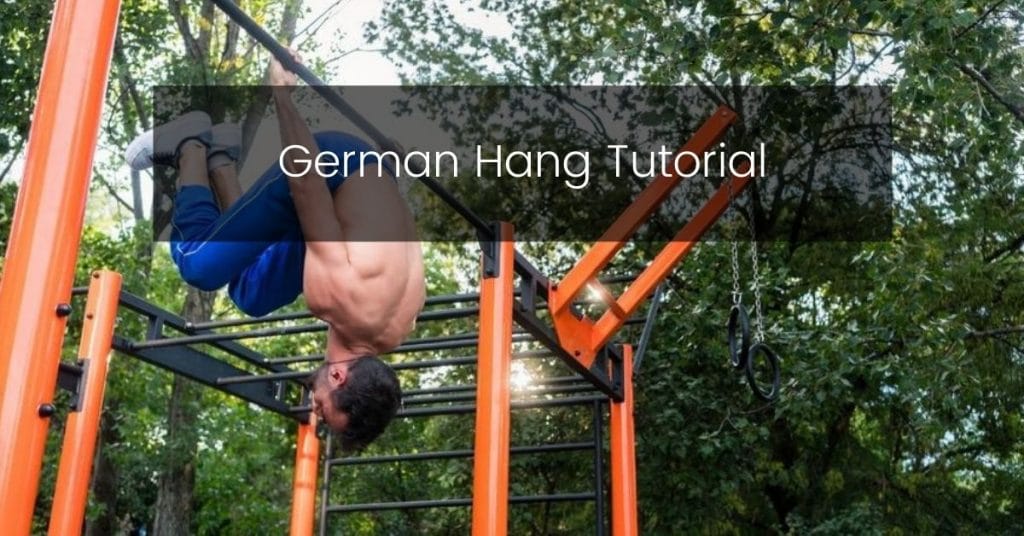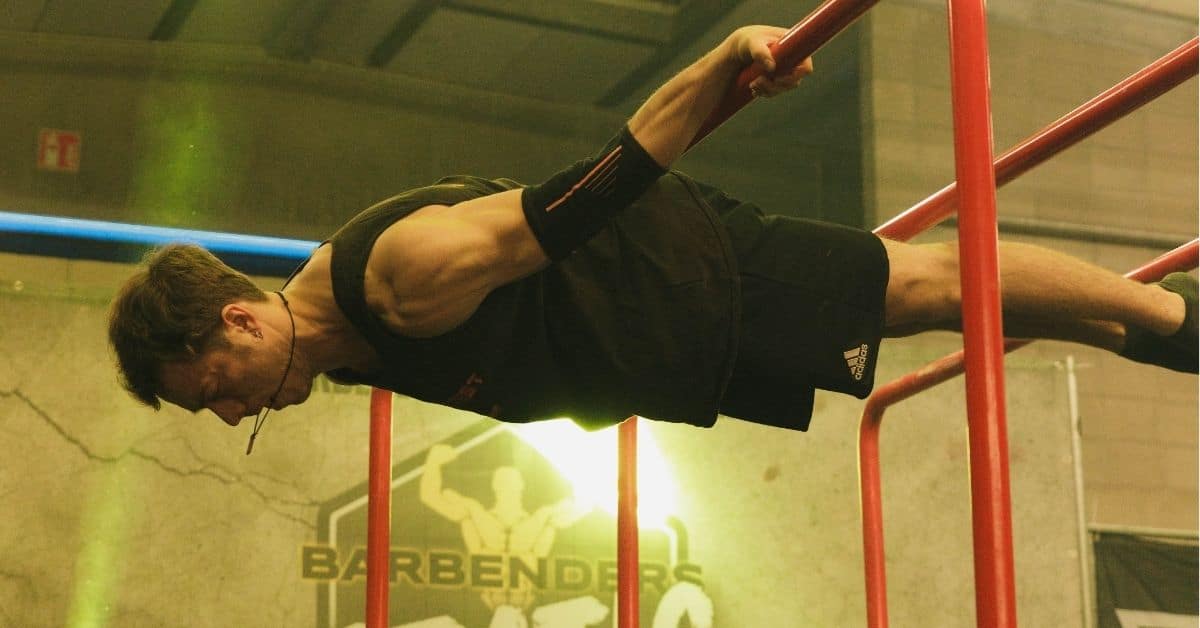In some ways, calisthenics can be easily and accurately viewed as an art form. It not only accompanies a high number of great-looking exercises but also includes a wide range of static holds that look incredibly elegant when performed. Among these holds and exercises is a stretch…
It is relatively well known although only often done by the more experienced individuals. In this case, I am, of course, talking about the german hang!
The german hang or – (german hang stretch) is a very complex stretch. If done incorrectly, there is a potential for serious injury and because of this factor, I have no other choice but to teach you how to do it right!
So, without further ado, allow me to present you with a german hang tutorial!
Firstly, you must learn the basics
Before even attempting this stretch, prioritizing the smaller movements first is vital. It will not only warm up the joints and muscles you use during the hang but it will help you to grasp the overall stretch.
To practice some of the basics of this stretch, you will need a straight bar running horizontally. With your hands behind your back and your palms facing down, firmly clasp your hands around the bar.
When done correctly, your body will be facing away from the bar and your hands, closely together, will be behind your back firmly clenching the bar. Ensure that your elbows are completely straight throughout this stretch.
Ensuring that your arms are straight and completely locked out is key as this will play a role when you perform the german hang stretch.
The main german hang benefits
- The hang provides a great shoulder stretch: when it comes to effectively performing the more advanced calisthenic movements and holds, having very mobile and flexible shoulders is a crucial thing to have. This exercise will not only help to prepare you for many of the other advanced movements but it will help you to develop stronger and more flexible shoulders.
- The german hang improves core strength: while all calisthenic movements improve core strength, none of them compares to the german hang. This increase in core strength can be attributed to the beginning of the hang. More specifically, from the starting point up until the middle point of the movement. This is when the core is most engaged and this is where core strength will be developed.
- It greatly improves overall grip strength: generally speaking, your grip strength determines your overall strength. While this is commonly debated among strength enthusiasts, your grip is often looked at as an overall measurement of your strength. Is this being the case, improving your grip strength all of a sudden sounds like a good idea right? Indeed it does and you can do precisely this with the german hang!
- The german hang stretches your arms: in terms of injury prevention and increasing mobility, stretching is very important. It not only increases blood flow to the stretched muscles but it improves mobility by stretching and contracting the muscle fibers. This being the case, since the german hang stretch provides such a great stretch on your arms, you can be assured it will help with other exercises.
This exercise is a gateway to success
As you all know by now, calisthenics involves many complex holds and movements. While some of these movements and holds can be tricky, some of them are easy. The german hang certainly isn’t beginner-friendly, slowly practising and mastering the hang will open the doorway to all of the other complex holds and movements you one day hope to do.
While the german hang does accompany more benefits than this, the four listed above are by far the main benefits to note. This is because the benefits listed above will not only be the most noticeable but they will benefit other exercises too.
One more thing, before you dive headfirst into doing the german hang, be sure to master the basics.
Taking it up a notch…
In the next section of this article, we will, quite literally, be taking it up a notch. Before I go any further, I just want to state that while it may seem a bit confusing, breaking down the german hang for teaching purposes is crucial. This very complex stretch is not something that anyone can do and it is best to be taught in smaller increments.
With all that in mind, let’s move on to the next step!
So, to take it up a notch, carry out the previous instruction listed. With the correct stance and positioning, extend the stretch by taking one rather large step forward. How far you stretch out should depend on how far you need to go until you max out the stretch.
When done right, you will feel a strong stretch in your forearms, biceps, triceps, shoulders, and even your chest area.
Key things to remember
When you are doing the stretches listed above, you must contract both your bicep and tricep with each and every stretch. This will greatly mimic how your arm will feel during the hang but it will also provide a greater stretch on your muscles.
Another very important key point is to warm up before doing any of the stretches listed.
I understand that advising to warm-up is a very tiring thing to hear at this point but believe me, going straight into stretches like this with stiff and achy muscles can result in torn muscle fibers which will only complicate matters further.
Lastly, if you are unsure of how to perform the stretches listed, watch a german hang tutorial on the internet and you should develop a better understanding of what I am asking you to do.
Beginning the german hang stretch
To start the beginning steps of this stretch, you will need a pair of the best gymnastic rings. Provided you have those, position them to the same height of your sternum. With this positioning executed, get yourself into the same stretched position I mentioned earlier.
Once you have done this, with both feet together, lower yourself down to the floor in a goblet squat-like position.
When done correctly, your arms will be extremely elevated back and behind your head whilst your body will almost be touching the floor. The idea behind this is to provide you with more of an idea of how the stretch will feel in full motion.
After mastering this stretch, let’s throw a bit of motion into the mix.
Mastering the motion
In this section, we will master the only portion of the german hang that involves movement and since you will have mastered the previous stretches, this should not be too hard.
So to start the movement portion of the german hang, ensure that the rings are kept at the same height as your sternum. With the rings in place, assume the goblet squat-like posture as previously discussed and grab hold of the rings extending both arms towards the ceiling.
From this point onward, jump up into an inverted hang, tuck up your legs and drop back slowly into the hanging position you previously practiced.
When done correctly, this will almost appear as though you are doing a backward rollie pollie with the one exception of your legs being straight up in the air during the inverted hang. Be sure to master this movement and once you feel comfortable, you can raise the rings to a higher elevation which will mean a more advanced form of the stretch since you won’t have assistance from the floor.
Key things to remember
As you practice and practice the final step provided, I would strongly suggest you watch a video of this being performed. By doing this, you will enable a deeper understanding of exactly what to do which will further speed up your results in this area.
The second key thing to remember is that, as previously mentioned, this is not a beginner-friendly stretch. If you are intent on learning this, you must be sure to not only master the techniques but must ensure you have enough strength to complete the movement.
Last but most certainly not least, as mentioned earlier, please warm up every muscle involved in this hang. Since the german hang provides a very powerful stretch on the muscles it targets, muscles that are not warmed up or stretched beforehand become very prone to injury.
Train safe guys!






